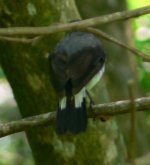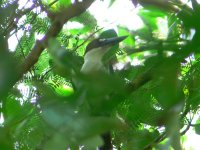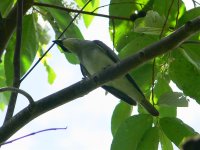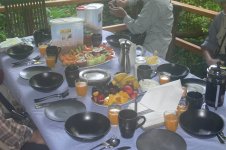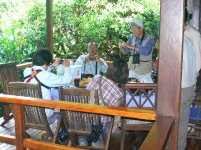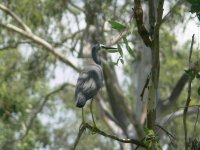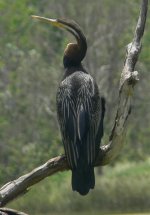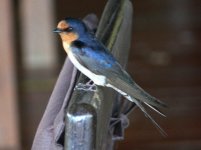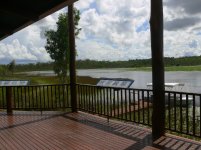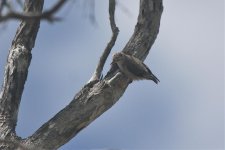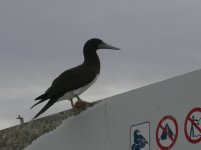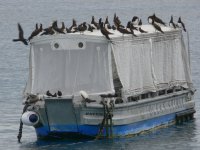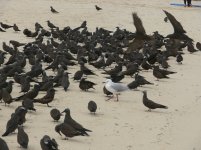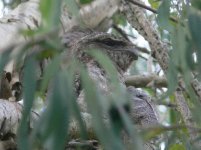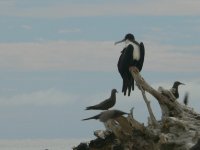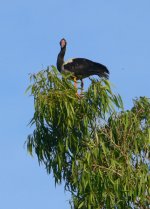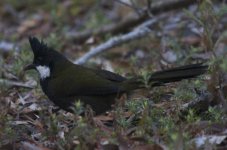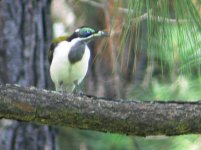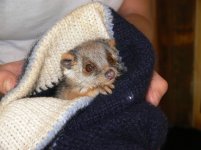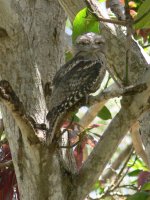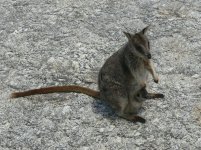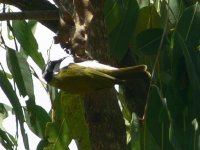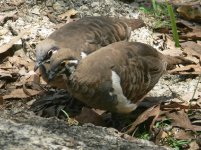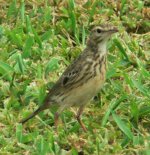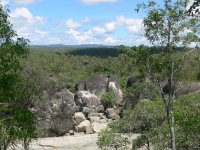Friday 17th December
Cassowary House – Black Mountain Road - Mareeba cemetery - Granite Gorge – Hastie’s Swamp - Lake Tinaroo - Lake Barrine - Curtain Fig - Tarzali Lakes
This mornings’ perambulatory birding was enlivened by the presence of Bobbie and Herb and, later, Phil himself. It’s no coincidence then that today, along with all the expected birds we managed my first good view of Cicadabird , another sighting of Australian King Parrot and confirmation my previous sighting of Pied Monarch. After my regular solo searching for another sighting of the latter, Phil promptly found one, almost to the branch, where I’d had my previous ‘possible’.
Off out after breakfast, our first, somewhat macabre, destination was Mareeba cemetery – a known site for both Blue-faced Honeyeater (which I’d yet to see well) and Apostlebird (which I, and more to the point Phil’s clients, hadn’t seen at all). The large flamboyant honeyeaters, arguably my favourite of this diverse group seemingly linked only by a common vernacular name, showed well. With several young birds present they were more “greeny-faced” than blue faced honeyeaters! Surprisingly, for a bird that usually appears in groups of a dozen or so (hence its name), we found just one Apostlebird; naturally Phil dubbed it the Judas Iscariot-bird! This species was a great contrast to the honeyeaters with its subdued mottled greyish colouring. Who could have imagined that several millennia of evolution could have so precisely anticipated the exact colour of the cinder path on which it stood?
From here we headed for Granite Gorge (c12km SW of Mareeba see www.granitegorge.com.au) – a wonderful little site and, in all probability, the easiest place on the planet to see Mareeba Rock Wallaby. However, although not listable, the prize for the cutest animal of the day went to the baby Ring-tailed Possum which the owner of the site, a wildlife carer, was nursing. As we exited the small reception area Phil asked after two species found here. Scarcely had he asked when the first, Squatter Pigeon, appeared more or less at our feet! The other species, Tawny Frogmoth, required a little more effort and several minutes of fruitless searching ensued. As we looked, on my prompting, Phil explained that they were much smaller birds than Papuan. But before he’d finished, I interrupted him with the words “I think they must be about the size of those two birds in the tree behind you!” and there they sat two distinguished looking Tawny Frogmouths. Whilst the Papuan Frogbirds had a kind of gloomy magnificence, these two had greater charm and a kind of Edwardian gravitas that just stopped them being ‘cute’ (well, almost!). With my cup now distinctly overflowing, before we left we had two of my favourite honeyeaters, White-naped and Yellow, plus another Pale-headed Rosella.
However, this was no time for resting on laurels so it was off to Hastie’s Swamp for more birds. A long narrow lake overlooked by an excellent tower hide this place encouraged an air of expectation – and we didn’t have long to wait for this feeling to be justified. The first lifer out of the stocks was Cotton Pygmy-goose; a striking little bird in repose made still more striking in flight by virtue of its bold white wing bar contrasting nicely with the striking emerald green of its back and wing coverts. An obliging Sacred Kingfisher did its best to distract us from the blossoming trees, but concealed within the latter’s branches were White-cheeked and Scarlet Honeyeater. If the first was a fabulous little bird then the second, a resplendent adult male, totally blew me away. With a fine curved bill, immaculate bright red body, black wings and tail, its plumage closely matched that of Scarlet Tanager! Also present was a calling Bridled Honeyeater whilst Phil glimpsed a probable Yellow-faced. Although it could scarcely compete a (Australian) Purple Swamphen showed very well here too. As we left, more in hope than in any realistic expectation, I carefully monitored the trees on the far side of the water for any sign of White-bellied Sea-eagle, a bird conspicuous by its continued absence. Naturally, since we were on something of a roll, one promptly appeared. This wasn’t a long visit, but, goodness, it was a quality one!
The next location to be visited was an arm of Lake Tinaroo in the hope of a few waterbirds. The brief stop netted Coot (‘our’ version, but given its isolation perhaps not beyond being split), Wandering Whistling Ducks and a very obliging Australian Pipit. Once again, though, the star bird here was delivered up by Phil’s knowledge of local bird song – a White-throated Gerygone. A sweet songster, confusingly this bird’s most obvious character was its brilliant yellow underparts. By now it was time for lunch so we stopped at the excellent Whistle Stop Café in Yungaburra (which was by far the most attractive little settlement I’d seen in Oz and worth a quick stop).
Continuing on we headed for Lake Barrine, a beautiful crater lake nearby. Somewhat implausibly, to a British observer that is, this is home to a colony of Great-crested Grebe. One of the stars here, though, was a tree, or rather two, the massive 1,000+ year old Black Kauri (Agathis atropurpurea) a species of conifer found only in Queensland. As we returned to the car we found some honeyeaters – the quietly handsome if understated – Dusky Honeyeaters feeding in a small flowering tree, but, hold on, what was that spectacular bird feeding with them? That I failed to ID them instantly I put down the deafening sound of my brain shouting ‘Hells bells what’s that fantastic wee beastie?’ The ‘wee beastie’ was, it transpired, an Eastern Spinebill. I hadn’t appreciated that this stunning little ‘bobby-dazzler’ was ‘on the cards’ and Phil had neglected to tell me that this was a good site for them. Like a magician producing a rabbit from the hat, Phil liked to surprise me with the odd bird, but sometimes it would have been good to know even at risk of being disappointed! Then it was off to see the extraordinary Curtain Fig which was not far away. First, though some birding – Black-faced and Pied Monarch (again!), Golden Whistler, Grey-headed Robin and a Little Bronze-Cuckoo. At this point I ought to confess that the bronze-cuckoos had me confused – we’d had both of what seemed to be Little and Gould’s, but Phil was firmly of the opinion that they were conspecific.
Our final stop was Tarzali Lakes Aquaculture Centre (www.tarzalilakes.com) near Malanda where, on Sue’s instructions, Phil was to pick up some home cured bacon (or was it ham. Phil?). As we turned into the place with his trademark studied insouciance Phil commented that this was where we’d get Duck-billed Platypus …. oh yeah and the rest, Phil. It was with great confidence, though, that Phil led us over towards a more distant pool where, within a few minutes, we had indeed seen a Duck-billed Platypus! Although at first distant, I eventually got excellent views of this bizarre animal. I’d had firm instructions from my daughter when I left home that I mustn’t return without seeing one and here it was! Blessed with a more expressive pen than I possess I could write paragraphs about this extraordinary animal and what seeing one meant to me. Not being so blessed, I can only repeat that I really had seen an egg laying, poison spurred duck-billed relict of evolutionary history. Utterly amazing and something I have dreamt of seeing since early childhood! Even if they proved easier to see than I’d ever imagined and despite my birding blinkers, this was the lifer of the trip.
As we watched the platypus, the owner of the place, a friend of Phil’s naturally, came over for a chat. A large, bluff bloke (and only ‘bloke’ fits here), he spoke fondly and authoritatively about ‘his’ platypuses. This was no surprise, but to hear him, a fish farmer, wax so lyrical about White-bellied Sea-Eagle (one of which had just flown over) was as refreshing as it was unexpected. This was another terrific place and certainly an un-missable destination if you visit the area. As we walked happily back to the car (despite the drizzle) a group of Fairy Martins came over amongst which were a Tree Martin or two – another lifer. By now I knew that that Phil’s encyclopaedic birding brain never shuts down so I was hardly surprised when he picked up a singing Tawny Grassbird as we pulled out of the centre’s drive. I was pleased, though, that it was me that spotted the two birds, large long tailed birds like a cisticola on steroids, on the opposite fencepost.
It was skill, rather than pride, that gave Phil the last word. Driving home en route to Kuranda, he spotted two large birds distantly winging their way across the fields to roost. We stopped and, although getting a clear enough view, the duo had me totally perplexed. Very large long tailed and long winged birds with a deep wing beats I couldn’t place them in a family let alone a species. No puzzle to Phil, he promptly identified them as Red-tailed Cockatoos (birds he’d previously suggested we’d see in the area). My confusion partly stemmed from the fact that I’d never realised that these parrots were as big as a medium sized eagle. So ended a third contender for my best ever day in the field although this time the accolade rested more on an almost mythical mammal – Duck-billed Platypus - than any of the birds no matter how good! It was greatly helped too by the excellent company provided by Herb and Bobbie.




